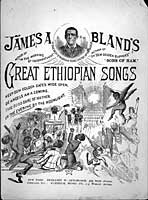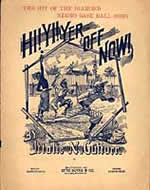The sheet music in this digital collection has been selected from the Sheet Music Collection at the John Hay Library at Brown University. The full collection consists of approximately 500,000 items, of which perhaps 250,000 are currently available for use. It is one of the largest collections of sheet music in any library in the United States. The sheet music, primarily vocal music of American imprint, dates from the 18th century to the present day, with the largest concentration of titles in the period 1840-1950.
Categories of particular note in the full collection include 19th century color lithographs; the works of Boston lithographers; music relating to World Wars I and II; music from the Yiddish-American stage at the turn of the century; early American imprints; Confederate imprints; Broadway show music; movie music; musical settings of American poetry; Rhode Island music; octavo band arrangements; and a very large collection of general popular music of the 19th and 20th centuries.
One of the most important categories in the Sheet Music Collection is the African-Americana. This consists of music by and relating to African Americans, from the 1820s to the present day, and consists of approximately 6,000 items. Of that number, 1,700 items are fully cataloged in MARC format, from which the titles digitized in this project have been drawn.
The African-American related sheet music includes songs from the heydey of antebellum blackface minstrelsy in the 1850s and from the abolitionist movement of the same period. It includes numerous titles associated with the novel and the play Uncle Tom's Cabin, so greatly influential in its day. Civil War period music includes songs about African-American soldiers, a controversial topic of the time, and the plight of the newly emancipated slave. Post-Civil War music reflects the problems of Reconstruction and the beginnings of urbanization and the northern migration of African Americans, notably in the music associated with the Harrigan & Hart shows of the 1880s. Sheet music of this period further documents the emergence of African-American performers and musical troupes, first in blackface minstrelsy, and later at the beginnings of the African-American musical stage in the late 1890s. The works of African-American popular composers, including James Bland, Ernest Hogan, Bob Cole, James Reese Europe, and Will Marion Cook are a prominent feature of the music of this period. The turn of the century period includes rags and the so-called "coon" songs, whose strident racial images have lost none of their power to shock. Twentieth century titles feature many photographs of African-American musical performers, often in costume. The music associated with World War I depicts the African-American soldier, and the period ends with works that point to the age of jazz, blues, and the lively African-American musical theatre of the 1920s.
The African-American sheet music provides a window into the daily concerns, preoccupations, and pastimes of Americans in the 19th and early 20th centuries. Unlike many other sorts of published works, sheet music can be produced rapidly in response to an event or public interest, and thus is the source of relatively unmediated and unrevised perspectives on quickly changing events and public attitudes. For example, the Civil War song known as "We are coming Father Abra'am" concerning the controversial military draft quickly changes when "300,000 strong" soon turned into "600,000". The plethora of songs relating to the novel Uncle Tom's Cabin, some with lyrics by well-known poets such as the abolitionist John Greenleaf Whittier, and others written for the stage versions of the novel, demonstrate its instant popularity and long-term appeal.
Particularly significant and important in the Collection are the visual depictions of African-Americans which provide much information about racial attitudes over the course of the 19th and early 20th centuries. For example, current discussions of the perceptions of African-American men find historical models and sources in the images of these men on sheet music covers for the entire period. Two archetypes, the rural, uneducated plantation "darky" figure (Jim Crow) and the urban, flashily dressed, fast-talking figure (Zip Coon) can be traced through sheet music covers and lyrics from the 1820s (before the period established for this project) through the 1920s. The ways in which these archetypes evolve in the public mind are clearly demonstrated in the sheet music. The plantation "darky" comes to include the "Uncle Tom" character, the "contraband," the migrant worker, the sharecropper; the urban figure emerges ominously as the "bully" in the post-Reconstruction era, and is also seen as the gambler, the cake-walker, the "swell". All these notions are clearly documented in the sheet music and afford much material for investigation.
The sheet music covers often include scarce and otherwise unavailable portraits of performers well-known in their day, including many African-American performers. Included are lithographic portraits of Cordelia Howard, the first "Little Eva" in the play of Uncle Tom's Cabin, reproduced from a Joseph Brady daguerrotype; vignette portraits of the well-known African-American composer James A. Bland, best known for "Carry Me Back to Old Virginny"; and halftone portaits of such major figures of the turn-of-the-century African-American musical theatre as Bert Williams and George Walker, Bob Cole and J. Rosamond Johnson, and Aida Overton Walker, great stars of the period, and many others. The transition from minstrelsy to the forms of the African-American musical theatre is clearly depicted in this music. Nowhere is this more evident than in the covers that depict African-American performers both in character in the old minstrelsy costumes and as themselves in conventional modern evening dress.
The inclusion in the project of not only the covers but digitized images of the musical notation and the lyrics means that researchers may examine, for example, the evolution of the "cake-walk" through the numerous versions present. Further, it is possible to explore the use of dialect and the evolution of slang terms in lyrics spanning seventy years. Researchers may compare the cover depictions of African-American related dance with the descriptions in the lyrics, illuminating an often elusive aspect of culture, and will be able to study the compositional techniques of African-American composers such as Ernest Hogan, James A. Bland, Sam Lucas, Dan Lewis, James Reese Europe, and Will Marion Cook. Perhaps most importantly, it will allow researchers to trace the history of themes such as religious beliefs, the status of women, attitudes toward multiracial individuals (particularly women), the impact of northern migration and urbanization on southern rural workers, among many other topics reflected in this form.
This digital collection places before the scholarly community, students at all levels, and the general public a significant body of material that illuminates in a direct, vivid, and dramatic way many aspects of American culture and society from the 1850s to the 1920s, including theatre, music, and dance, publishing history, music printing and illustration, as well as a variety of social concerns and events from abolitionism and the Civil War, the problems of Reconstruction, urbanization, the African-American soldier in three wars, and the social position of and attitudes toward African Americans throughout a critical period in history.
The digitization and presentation of these materials by Brown University Library* were supported by an award from the Library of Congress/Ameritech National Digital Library Competition.
The source materials for this collection are housed at the John Hay Library* at Brown University*. Please contact Reader Services* at the Hay Library for information about the original materials or requests for reproductions.




